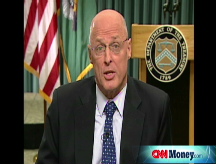Bracing for a roller-coaster recovery
An economic rebound may be far in the distance, but stocks usually stabilize first. Here's why the market should wobble in place in the second half of the year.
NEW YORK (CNNMoney.com) -- An economic and housing rebound may be a ways off but Wall Street is already in recovery mode. And that should translate into happier times for investors during the second half of the year.
It won't be a smooth ride, though. In fact, the next six months may feel more like stepping off the Tilt-A-Whirl at an amusement park. You're no longer really moving, but you still feel queasy.
"I think we're in a trading range, but it's a broad one and you can have a lot of volatility," said Beth Dater, chief investment officer at AG Asset Management. In fact, there doesn't appear to be any catalyst for a broad rally or a steeper selloff, Dater explained.
While stocks are still poised to end the year lower, the decline will not nearly be as substantial as the loss accrued in the first half, said Haag Sherman, managing director at Salient Partners.
As the first quarter draws to a close, the Dow, Nasdaq and S&P 500 are all down at least 8% year-to-date as of Thursday.
The low for the S&P 500 over the last 52 weeks was 1,257 in March, while the high was 1,576 last October. Dater said that the market isn't likely to break that lower level, barring a major unforseen crisis. It's also extremely unlikely that it will surpass 1,500 again this year.
There is still much to cheer about.
Stocks lead the news. Stocks typically anticipate a recovery around six months ahead of time. So, while the economic rebound is probably at least a year away, if stocks follow their typical pattern, that could mean a slight pickup by year end.
That has often been the case during other periods in which the U.S. was in a recession, or official "contraction" as defined by the National Bureau of Economic Research.
Technically, the U.S. isn't in a recession. But regardless of semantics, it feels like one to most people right now - gas above $4 a gallon, a weak job market and a battered U.S. dollar will do that for you.
In 3 previous recessions, stocks managed to post gains regardless. March 1991 brought the end of a recession and that year the S&P 500 gained 26.3%. 1980-1982 brought the so-called double dip recession, but stocks still gained soundly in 1980 and 1982, when each of those two recessions ended.
The last official recession bucked the trend. It occurred between March and November 2001, following the bursting of the tech bubble and the aftermath of 9/11. That year the S&P 500 fell 13%.
While it's unlikely the market will see the same type of gains as in recessions past, stocks should strat to stabilize as the year winds down, said Matt King, chief investment officer at Bell Investment Advisors. An improvement in GDP growth, an increase in corporate earnings and some strong seasonal factors could all add to a year-end boost, he said.
"If we get decent earnings for the second and third quarters, that could help," said Dave Rovelli, managing director of U.S. equity trading at Canaccord Adams. However, financial sector results are expected to remain dismal as the fallout from the credit crisis continues. And as long as financial stocks continue to slump, it's going to be hard for the broader market to move much, he said.
The upcoming presidential election adds a layer of uncertainty, but is not really impacting investment decisions now, said Robert Loest, portfolio manager at Integrity Funds. He said that's because any changes, regardless of which candidate is elected, won't be felt until at least 2009. (For more on Wall Street and the election, click here.)
The Fed, oil and the dollar. Most analysts agree that while the stock market wouldn't like it in the short term, higher interest rates would help in the longer term.
That's because the low interest rate environment, while helpful for the sluggish economy, has hurt the U.S. dollar and contributed to a rise in dollar-traded commodity prices.
It's true that commodity prices were already on the rise because of growing world demand, the role of market speculators and other factors. But Salient's Sherman said that the plunging dollar has added as much as $50 to the price of oil, currently hovering around $135 a barrel.
Sherman doesn't think the Fed will raise rates enough to help the dollar, largely due to the still-struggling economy and credit markets. If the Fed started inching rates higher, it might be taken as a vote of confidence that the Fed thinks the economy can take it, said Steven Rogé, PM at R.W. Rogé & Co.
But Sherman thinks August may be far enough off to bring a rate hike, which is already being anticipated. "If you are faced with a deterioration of credit and home prices anyway, you might as well fight what you can," he said. "Namely, inflation."
Sector-by-sector. Stocks and sectors that can withstand a slowdown and companies that conduct a majority of their business outside the U.S. will likely do best in this period, the analysts said, not to mention international equities.
Companies that are dependent on the U.S. consumer and financial companies are clearly to be avoided, said Integrity Funds' Loest. But companies that deal in raw materials, machinery and anything that contributes to infrastructure building will see growth, due to the international demand, he said. "To the degree that people invest globally, they will do well."
While a stronger dollar could cool energy prices a bit, global demand means that prices will still remain high for some time, said John Merrill, chief investment officer at Tanglewood Capital Management. While that's bad for the economy, it's good for "energy stocks and anything else riding the coattails of the inflation train," he said.
He said that technology and certain chunks of the healthcare sector will do well too. "I think there's a good chance the market will end the year higher than now or not far from where it started the year," he said. But feeding that will be strength in the select sectors mentioned and weakness in the others. ![]()




